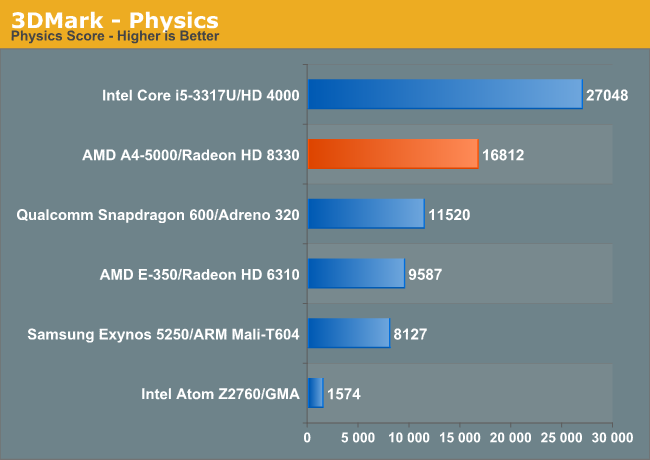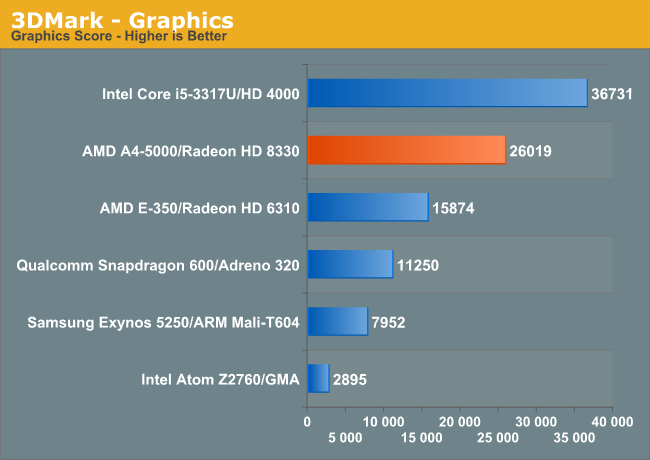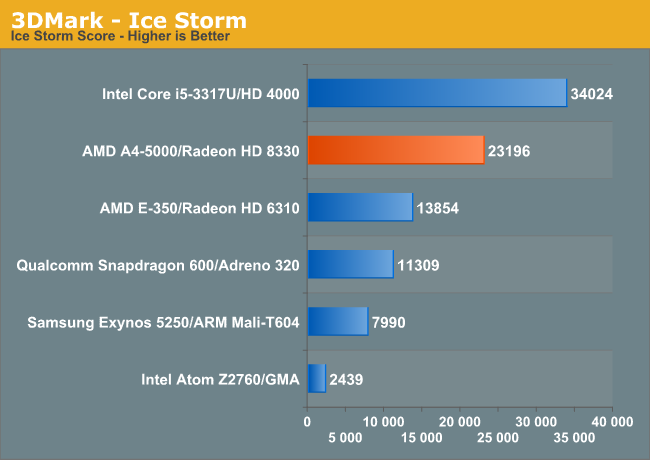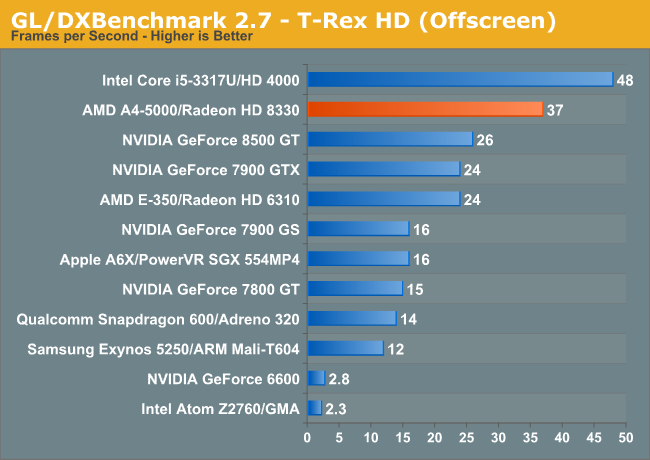The AMD Kabini Review: A4-5000 APU Tested
by Jarred Walton on May 23, 2013 12:00 AM ESTKabini vs CT/ARM: GPU Performance
I pulled out 3DMark and GFXBenchmark (formerly GL/DXBenchmark) for some cross platform GPU comparisons. We'll start with 3DMark Ice Storm and its CPU bound multithreaded physics benchmark:

The physics test is a bit unreasonably multithreaded, which is why we see a 75% uplift compared to AMD's E-350. For FP heavy game physics workloads however, Jaguar does quite well. While a big Ivy Bridge is still going to be quicker, AMD's A4-5000 gets surprisingly close given its much lower cost.
The 3DMark graphics test is more of what we're interested in seeing here. Two GCN compute units (128 SPs/cores) running at 500MHz will really put the old Radeon HD 6310 in Brazos to shame:

The results are quite good. Kabini manages a 61% performance advantage over AMD's old Brazos platform, and actually gets surprisingly close to Intel's HD 4000 in performance. As we discovered earlier, this isn't really enough performance to play modern PC games but casual (and especially tablet) gaming workloads should do wonderfully here.

The overall Ice Storm score just incorporates both physics and graphics test components. As expected, Kabini continues to lead over everything other than the i5-3317U.
Finally we have the GFXBenchmark T-Rex HD test. I threw in a handful of older PC GPUs, although keep in mind that T-Rex HD isn't very memory bandwidth intensive (penalizing some of the old big PC GPUs that had good amounts of memory bandwidth). The test is also better optimized for unified shader architectures, which helps explain the 8500 GT's excellent performance here.

Kabini does very well in this test as well. If we look at the tablet-oriented Temash part (A4-1200) we see that the number of GCN compute units remains unchanged, but max GPU frequency drops to 225MHz from 500MHz. If we assume perfect scaling with GPU clock speed, Temash could offer roughly the same graphics performance as the 4th generation iPad. AMD claims the A4-1200 Temash APU carries a TDP of only 3.9W, a potentially very interesting part from a GPU perspective if our napkin math holds true.
OpenCL Performance
For our last comparison we're looking at the OpenCL performance of these on-die GPUs. We're using a subset of Ryan's GPU Compute workload, partially because many of those tests don't work properly on Kabini yet and also because some of those tests are really built for much more powerful GPUs. We've got LuxMark 2.0 and two CLBenchmark 1.1.3 tests here. Their descriptions follow:
SmallLuxGPU is an OpenCL accelerated ray tracer that is part of the larger LuxRender suite. Ray tracing has become a stronghold for GPUs in recent years as ray tracing maps well to GPU pipelines, allowing artists to render scenes much more quickly than with CPUs alone.
CLBenchmark contains a number of subtests; we’re focusing on the most practical of them, the computer vision test and the fluid simulation test. The former being a useful proxy for computer imaging tasks where systems are required to parse images and identify features (e.g. humans), while fluid simulations are common in professional graphics work and games alike.
| OpenCL GPU Performance | ||||||||||||||||
| LuxMark 2.0 | CLBenchmark—Vision | CLBenchmark—Fluid | ||||||||||||||
| AMD A5-5000 (Radeon HD 8330) | 18K samples/s | 1041 | 1496 | |||||||||||||
| AMD E-350 (Radeon HD 6310) | 23K samples/s | 292 | 505 | |||||||||||||
| Intel Core i5-3317U (HD 4000) | 107K samples/s | 819 | 1383 | |||||||||||||
LuxMark is really a corner case here where Kabini shows a performance regression compared to Brazos. The explanation is simple: some workloads are better suited to AMD's older VLIW GPU architectures. GCN is a scalar architecture that is usually going to net more efficient usage, but every now and then you'll see a slight regression. Intel's HD 4000 actually does amazingly well in the LuxMark 2.0 benchmark.
Our two CLBenchmark tests however paint a very different picture. Here Kabini not only significantly outperforms its predecessor, but is faster than Ivy Bridge as well.










130 Comments
View All Comments
Gaugamela - Thursday, May 23, 2013 - link
And by the way. HP announced the Pavilion 11 Touchsmart for 400$ with this A4 and the A6 APU. So 20% less than those wonderful i3 Ivy Bridges of yours and with a 10 point touchscreen.Jeez, I wonder if it's good enough to compete?
whyso - Thursday, May 23, 2013 - link
There are already $400 ivy bridge touchscreen i3 ULV notebooks.Gaugamela - Thursday, May 23, 2013 - link
With promotions. And there's no one saying that 400$ is the minimum price point that Kabini can achieve. Lets see what other OEMs will show in Computex. Because it can go lower.Ivy Bridge is an architecture in end of shelf life. Promotions are bound to happen. Those weren't the normal prices of notebooks of a freshly released architecture and if you were intelectually honest instead of trolling like a jackass you would recognize that.
JarredWalton - Thursday, May 23, 2013 - link
Core i3 ULV laptops are routinely selling for $400 now. The ASUS VivoBook X202E for instance is at Amazon for $399 right now and comes equipped similarly to the Kabini prototype (other than the LCD of course), and it provides a touchscreen:http://www.amazon.com/gp/product/B009F1I1C4/ref=as...
The closest I can come to that with an AMD APU right now has...a Kabini processor and it's on preorder. What's more, it's the A4-1250 Kabini that cuts the CPU and GPU clocks by about 30% relative to A4-5000. The A4-5000 might be competitive with an i3-3217U, but the A4-1250 won't be (other than battery life, which should be slightly higher).
http://www.amazon.com/gp/product/B00CM1AAOG/ref=as...
Gaugamela - Friday, May 24, 2013 - link
You should refrain from commenting because you are just digging yourself deeper and showing bias against AMD. Which is pitiful since with a website with the reputation and impact that Anandtech has you should strive for impartiality. HP announced that the Pavilion 11 Touchsmart will come with a Temash and Kabini APU. Price will start at 400$ at launch.Less than that Acer, which I agree is a terrible deal and is overpriced because it is sporting hardware from a new generation. But again, you are just showing poor knowledge since that Acer doesn't bring a Kabini APU but a Temash APU. An APU with even lower TDP than what you reviewed in here - and you can also go check a decent review of the APU in that notebook in other websites since you guys don't seem to bother or care with those details since "it's AMD".
But you, more than anyone else should know that when a CPU generation is nearing the end of its shelf life you usually see a lot of deals of notebooks with that silicon. Good consumers will use that chance to get cheaper and great notebooks but that doesn't invalidate the launch of new hardware that, when launched will sell for higher prices.
JarredWalton - Friday, May 24, 2013 - link
You're one to talk about bias; check the mirror please. All I'm saying is that Kabini (and Temash) need to offer compelling price/performance/features against the competition. It doesn't matter whether the competition is "nearing the end of its shelf life" -- it's there and AMD, Intel, NVIDIA, etc. have to deal with this sort of thing all the time. I recommend products based on what's best, at a given price, and right now a $400 Ivy Bridge ULV laptop is going to be difficult to beat with a slower APU and a similar price point.Your "Ivy Bridge ULV is EOL" comments are actually wrong as well. Did you know ULV Pentium and Celeron parts just launched last quarter? Did you know that Intel is still making and selling Core i3 Sandy Bridge parts? Of course you did, because you want comparisons against the two-year-old Sandy Bridge parts so that Kabini looks better. The truth is that laptops with Ivy Bridge are going to be around for a long time. Pretending otherwise is dreaming, and of course you'll disappear when proven wrong or come back as a new user to spread more FUD when your fantasy predictions don't pan out.
Ultimately, it will depend heavily on what the OEMs deliver -- and when they deliver it. The Pavilion 11 Touchsmart at $399 doesn't seem too bad, but what do you really get? Oh, that's right: it *starts* at $399, and that will almost certainly be with Temash as you're so keen to point out. But Temash is just Kabini at lower clocks and potentially two CPU cores instead of four. Do you know how bad an A4-1250 will look compared to an i-3217U, or a Pentium 2117U, or even a Celeron 1037U? Those should all be priced $400 or less, with the major difference being L2 cache and the lack of Quick Sync on Pentium and Celeron. I've seen some benchmarks elsewhere, and basically the A4-1250 is often half the performance of the Kabini A4-5000 reviewed here.
Kabini is much better than Brazos and Atom, no doubt about it. It's also slower than Ivy Bridge ULV in many tests, and areas where it does win (some GPU benchmarks) are often meaningless for the Windows laptop market. (“Oh, you’re faster at running games! I can get an unplayable 15FPS compared to an even more unplayable 13FPS!”) On an Android tablet, Kabini and Temash will do much better, but for Windows they're at best "fast enough", while other similarly priced laptops are going to be faster. Who buys a slower part for the same price? I’m not sure, but as an unbiased tech journalist I’m certainly not going to recommend doing so.
rocketbuddha - Friday, May 24, 2013 - link
The reason why Kabini and Temash are good for AMD is the following.Clock for clock they are better than Sandy i3 ULVs and equal to Ivy i3 ULVs. They provide a better battery life than the ULVs but most importantly they have a smaller die size than their Core competition and are being made in a mature 2 + year 28nm Bulk HKMG process from TSMC.
For the first time, AMD is giving a good performance and a lower die-size than Intel. Previously AMD had to compete in price and/or price/performance with a large die-size. No longer is it handicapped in that manner and this time it can definetely make an impact.
Also JAGUAR architecture has made its way into both PS4 and XBox-one as semi custom APU and it will only make things better and easier for AMD.
whyso - Thursday, May 23, 2013 - link
The name calling is uncalled for. I can respectfully disagree. Who cares about promotions or not? I care (and the consumer cares) about the price that they are paying out of their wallet; that is what matters in the market. Ivy Bridge is going to get discounts because its going EOL. That is the market that kabini will have to compete in.Gaugamela - Friday, May 24, 2013 - link
Yes, the consumer cares about promotions but my point is: Kabini notebooks won't have to compete against Ivy Bridge discounted notebooks except for a small portion of their commercial life.And if Kabini needs to compete with that, the same can be said about Haswell, Richland, etc, etc. Every new notebook that gets in the market now will compete with promotions for the older models being cleared out and it's not those promotions that will affect their success or not.
And that's the point I am making and that you fail to understand. Promotions happen all the time, they direct the consumer to one product above another but they are temporary. And the flaw in your reasoning is assuming that Kabini/Temash notebooks will face Ivy Bridge notebooks with promotional prices during all the time they are going to be for sale and not recognizing that promotions happen for all products and aren't exclusive of Ivy Bridge notebooks.
whyso - Friday, May 24, 2013 - link
No haswell will be more expensive but offer more performance.Promotions happen all the time but if they happen all the time then they might as well be considered as non temporary (like dell's discounts).
I have no doubt that promotions will happen for kabini I'm just saying that $500 is too much for a notebook of this class. Its not an i3 ULV competitor (see TH for i3 ULV comparison) and at this moment must be compared pricewise to the market its in.